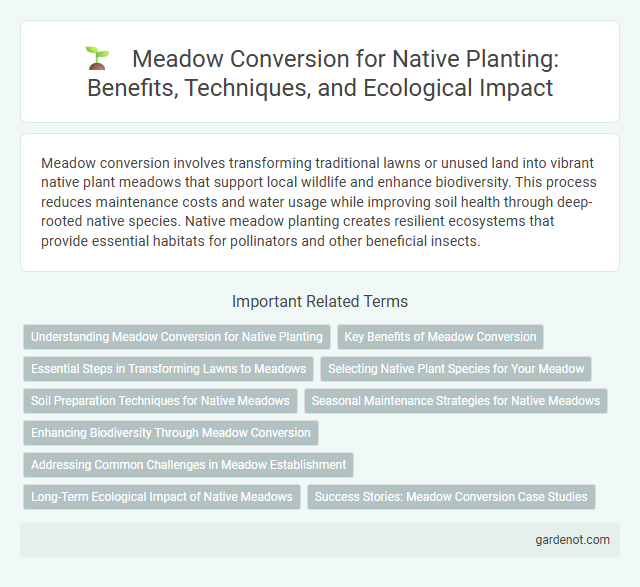Meadow conversion involves transforming traditional lawns or unused land into vibrant native plant meadows that support local wildlife and enhance biodiversity. This process reduces maintenance costs and water usage while improving soil health through deep-rooted native species. Native meadow planting creates resilient ecosystems that provide essential habitats for pollinators and other beneficial insects.
Understanding Meadow Conversion for Native Planting
Meadow conversion involves transforming traditional lawns or degraded landscapes into thriving native plant meadows that enhance biodiversity and support local ecosystems. This process requires selecting region-specific native grasses and wildflowers that promote soil health, provide habitat for pollinators, and reduce maintenance costs compared to conventional turf. Effective meadow conversion integrates soil preparation, appropriate plant species mix, and adaptive management to ensure successful establishment and long-term sustainability of native plant communities.
Key Benefits of Meadow Conversion
Meadow conversion enhances biodiversity by providing native pollinator habitats and supporting diverse wildlife populations. This sustainable landscaping practice improves soil health through deep-rooted native plants that increase water infiltration and reduce erosion. Meadow conversion also lowers maintenance costs by reducing the need for irrigation, fertilizers, and mowing compared to traditional lawns.
Essential Steps in Transforming Lawns to Meadows
Converting a lawn to a meadow requires soil preparation, selecting native plant species, and phased planting to ensure ecological balance and sustainability. Removing existing turf often involves solarization or manual dethatching, followed by soil aeration and amendment to support meadow flora. Implementing a maintenance plan that includes seasonal mowing and invasive species control promotes native biodiversity and long-term meadow health.
Selecting Native Plant Species for Your Meadow
Selecting native plant species for your meadow ensures ecological balance, supports local wildlife, and enhances resilience to regional climate conditions. Prioritize a diverse mix of native grasses, wildflowers, and shrubs adapted to your specific soil type and moisture levels to create a thriving habitat. Incorporate species like little bluestem, black-eyed Susan, and purple coneflower to maximize pollinator attraction and biodiversity.
Soil Preparation Techniques for Native Meadows
Soil preparation techniques for native meadow conversion emphasize minimizing soil disturbance to preserve existing microbial communities and seed banks. Techniques include shallow tilling, scarification, or using a sod cutter to remove invasive species while maintaining soil structure. Incorporating organic matter and ensuring proper soil pH balance enhances native plant establishment and long-term meadow health.
Seasonal Maintenance Strategies for Native Meadows
Seasonal maintenance strategies for native meadows include timely mowing, targeted weeding, and selective prescribed burns to promote native plant growth and suppress invasive species. Implementing early spring mowing helps remove invasive annuals and stimulates warm-season grasses, while late fall mowing prevents woody plant encroachment and aids seed dispersal. Regular monitoring and adaptive management throughout the growing season ensure ecological balance and long-term meadow health.
Enhancing Biodiversity Through Meadow Conversion
Meadow conversion enhances biodiversity by restoring native plant communities that support pollinators, birds, and beneficial insects. Native wildflowers and grasses improve soil health and provide essential habitats for wildlife throughout seasonal cycles. This ecological restoration increases species richness and fosters resilient ecosystems tailored to local environments.
Addressing Common Challenges in Meadow Establishment
Meadow conversion faces common challenges such as soil preparation, invasive species control, and seed selection tailored to local ecosystems. Effective soil conditioning with minimal disturbance promotes native seed germination, while strategic removal of invasive plants prevents competition. Selecting regionally adapted native species ensures higher survival rates and long-term biodiversity in meadow restoration projects.
Long-Term Ecological Impact of Native Meadows
Native meadow conversion enhances biodiversity by supporting a wide array of pollinators, birds, and soil microorganisms, fostering a resilient ecosystem. Over decades, native meadows improve soil health through deep-rooted plants that increase organic matter and water retention, mitigating erosion and reducing runoff. These ecological benefits contribute to carbon sequestration and create sustainable habitats, promoting long-term environmental stability.
Success Stories: Meadow Conversion Case Studies
Meadow conversion projects have demonstrated remarkable ecological benefits by restoring native plant diversity and supporting pollinator populations. Case studies from the Midwest reveal a 40% increase in native wildflower coverage and a 30% rise in native bee species within three years of meadow establishment. These success stories highlight the potential for meadow conversion to enhance ecosystem resilience and biodiversity in urban and rural landscapes.
Meadow conversion Infographic

 gardenot.com
gardenot.com